February 4, 2006
The Matrix Trilogy: A Man-Machine Interface Perspective
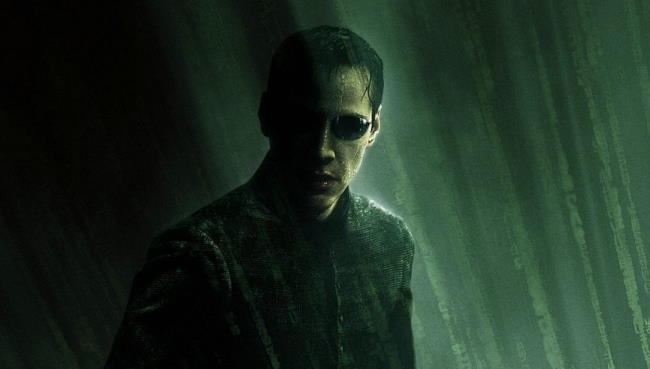
Overview: Since online debate around the Matrix Trilogy has been beaten to death, I’m guessing by now you’ve already long ago made up your mind on whether you liked or hated the Matrix and its subsequent sequels. Truly, whatever you decided is fine with me. As it turns out, I love them and generally think they’re great. And NO, I’m not really interested in having a Matrix Sucks/No You just don’t get it discussion. Please start a new thread in the Meatspace if you’re still interested in such banter. This essay is for something else - it’s about viewing the trilogy, specifically Neo, from a man-machine interface, or cybernetics perspective.
While most of the discussion around the trilogy deals with the classical philosophies expressed, very little discussion seems focused on a strictly sci-fi perspective. Why, I cannot say, but purpose here is to attempt to explain how the trilogy truly makes sense from a cybernetics perspective - a viewpoint that is just as intentional as the philosophical/religious journey. If you take the time to read this, forget about the philosophical and metaphysical stuff for a minute, and forget about any dialogue and acting issues you might have with the sequels. Instead, I want you to look at the trilogy purely as science fiction. Specifically I want to discuss Neo NOT as a messianic figure but as a Cyborg - a symbiotic combination of a sentient program and human being that evolves and integrates over the course of three movies. This essay assumes that you are familiar with all three movies, and will be filled with spoilers (I will also mention how Neo’s man-machine integration relates to the end of Ghost in the Shell).
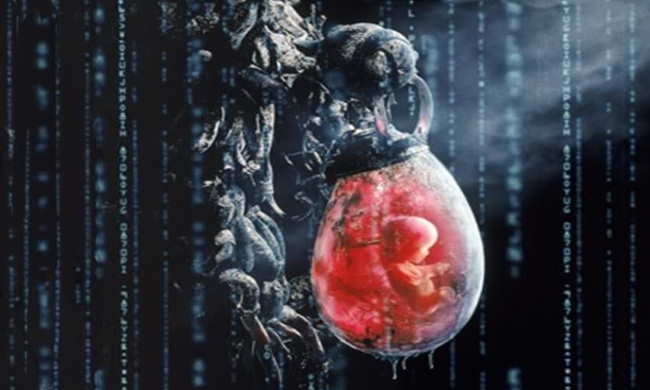
A Word about Battery People: Battery people are those humans who were birthed and raised in the Matrix. Both the Animatrix and the first Matrix movie makes clear that the former battery-people (those people stuck in the Matrix Pods from birth but who now live in Zion) are REPLEAT with electronic parts. Their entire nervous system is wired from head to foot. They have massive amounts of electronics in their brain that allow a virtual reality simulation to completely take over all sensory and perceptual elements. But the purpose of the cybernetic implants is two-fold – it is used to allow perceptual control of the battery people (cyborgs) and its designed to harvest and transfer human-generated energy into electricity.

What is the Matrix? The Matrix is the Machine City’s power plant. It is not the focus of the machine’s existence, it is merely their source of their energy. My guess would be that most sentient machines and programs care little more about the Matrix than you do about your local electric company. Only the power plant manager – the Architect – and those working for him are truly obsessed with the running of the Matrix.
Communicating With The Machine City: Every aspect of the machine city’s society (what little we know about it) is about wireless communications. The leader sentinels (the ones with the mini-satellite dishes) appear to be almost constant communication with the “source,” and then communicates orders to the drone sentinels (who do not appear sentient). The sentinels can only “see” energy. This is the reason that the humans shut down all power when the sentinels come (this way they cannot see the ship). However, given the above discussion on battery people, it’s also clear that Sentinels can “see” battery people when they run (The end of the Matrix and Reloaded shows this). The battery person, or “cyborg’s” implants, part of whose function is to harvest human energy, gives off some kind of energy that is noticeable.
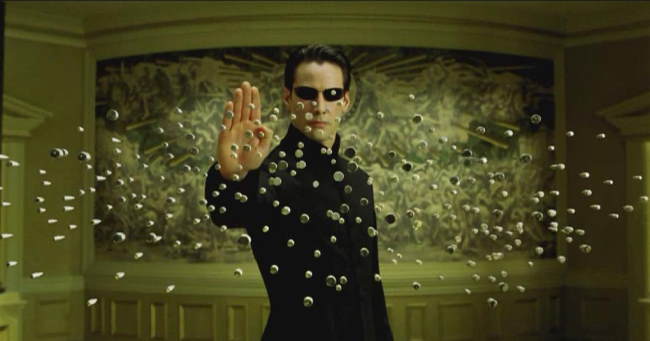
How is Neo Different From Other Battery People? Now lets get to Neo - in the Sci-fi interpretation, we find that Neo actually had a special package implanted in his head at birth that was different from the other battery people (re: the architect’s conversation). This package includes both a sentient program learns over time, and a method to communicate directly with the source. Neo the “person” is actually not just a person or even a normal “battery” person, but is a symbiotic combination of human and learning sentient program. The sentient program in a very real sense is “part” of Neo. It is not a virus living off a host – it is a fully integrated entity, which transforms Neo into a true man-machine organism just as Motoko was at the end of Ghost in the Shell. The sentient program’s communications package is necessary for the “One’s” eventual planned destiny – this is part of the architect’s control loop whereby the One returns to the source and freely agrees to let the human portion of him die, and then freely communicates the sentient AI part of him back to the source to reboot the matrix. The sentient portion of the One isn’t dead, and may eventually return to the Matrix, similar to how the sentient portion of Seraph (a former “One”) has done.
So Neo has the ability to communicate with the Source and, because of his unique purpose (to understand and update the Matrix, he has “sysadmin-like” machine city powers in a computer sense required to reboot the matrix (after all, this is his intended purpose). These two aspects – his sys-admin ability and wireless communications ability - provide that rationale for Neo’s ability to communicate/attack/destroy other machines and programs from the source both internally in the matrix and externally (wirelessly) in the real world. It’s also clear that Neo has the ability to see energy similar to the sentinels - this is different from a broadcast signal. Basically, Neo was given the same capabilities for sensory perception as the machines, and is the ONLY human that has the capability to send and receive wireless communications. Incidentally, for those matrix fans watching at home, this is why the 13th floor scenario (matrix within a matrix) makes no sense.
With this basis, the much talked about and often misunderstood scene near the end of Revolutions, where the “ghost” sentinel goes through Neo also makes sense. Neo has been attacking the sentinels and other machines wirelessly for some time. The ghost sentinel going through him is merely a return wireless attack by a foe who is changing their tactics to meet the enemy’s assault. The sentinel essentially did a ghost-hack type attack, where energy from the sentinel is sent back at Neo. And in fact, the attack was successful – so successful that it momentarily knocks out the sentient program portion of Neo, so only the human part is conscious. At this point, Neo cannot see the machines and cannot fight back, so he tells Trinity to go up above the nano-clouds that destroy all electricity and block out the sun.
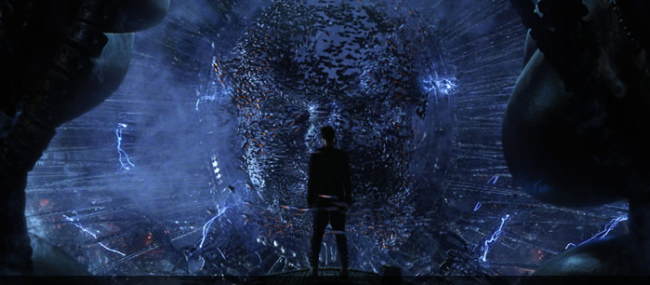
The Scifi View is Different: Again, I’m CLEARLY separating out the sci-fi view from the metaphysical/religious view here. If one takes the metaphysical view, Neo becomes self-realized, and this has nothing to do with sentient programs or all the rest - but then the “belief” in his powers has to do with more metaphysical/religious connotations. He becomes the “One” in the same way Buddha or Jesus did - through his path to self realization. This is a significantly different but parallel storyline. Both the religious view and the sci-fi storylines are significantly different, but just as intentional. To reiterate - the matrix trilogy is fully allegorical in the sense that the entire trilogy was INTENDED to be viewed from separate and distinct story lines. This also addresses one of the many knocks on the trilogy – many knock many of the key scenes as incoherent or vague. This was purposeful action on the part of the Wachowskis. Most of the key scenes are “specifically” vague just so that they can be properly interpreted in two completely separate storylines. More than anything else, this truly is the magnificence of the story line across all three movies.
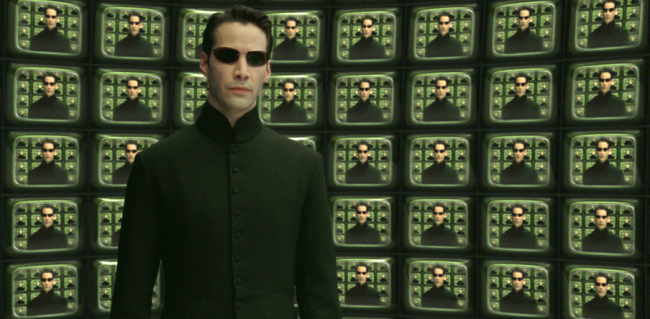
Recap and Explanation: To reiterate, all battery-people are FULLY embedded with cyborg components that can completely take over full perceptual control - this was made abundantly clear in the first movie. The cyborg components run completely throughout their nervous system - only the outside pieces are ever removed. If you view the trilogy with these points in mind, here are some actual plot points to reconsider:
- The sentient program in Neo first “turns on” and temporarily “takes over” the body “Neo” when the human portion of him dies in the first Matrix movie (M1).
- This explains why the agents want to kill Neo in M1, even though he’s the key to the architect’s control system (another question often asked). To meet the Architect’s needs, the sentient program portion of Neo has to fully engage and this only happens with the death of the host. The Oracle knew this, which is why she “predicted” this.
- The integration proceeds throughout Matrix Reloaded (M2) - this is how Neo “sees” the matrix green and now “yellow” energy of the machine city code. Some say the cookies and candy provided by the Oracle helped with the symbiosis process (others say this was her way of subverting the Architect’s intent).
- The architect states that Neo needs to freely provide this code back to the machine city (which communicates though wireless communications) in order to reboot the matrix. This explains both the wireless capability and the need for the sentient program, which is a product from the machine city, to have the same sensory perception as other things from the machine city.
- The purpose of the sentient program is to fully understand current human thought process and the nature of their evolved perception so that it can reboot the Matrix effectively to return the negative feedback control system (that’s a cybernetic term, not meaning “bad” feedback”) back to its initial goal state. This explains the rationale for the sys-admin-like powers.
- Combining the wireless capability and machine city sysadmin-like powers, the sentient program portion of Neo now has the ability to “attack” machines outside of the matrix.The CLEAR sign of this was near the end of Revolutions, when the machine “ghost” launched an attack back at Neo as he approached the Machine city. The wireless portion of Neo was knocked out, so Neo, now dazed, was no longer able to either see or hurt the machines - in a reverse from his death in M1, now on the human portion of Neo was operating alone.
- This also explains how Mr. Smith was able to get powers outside of the Matrix. Because he mixed with Neo’s essence, in fact what happened is Mr. Smith obtained a portion of Neo’s sentient program which mixed with the Agent, creating something altogether new and deformed. (which is why Mr. Smith is orange in Matrix colors versus something yellow or green). Mr Smith as a sentient program invaded a battery-person who still had all the implants that any battery person does, but Mr. Smith could not attack Neo wirelessly, as he didn’t have the extra hardware needed.
- Seraph also provides support for this understanding. He is a former “One”. The sentient program portion of him is all that exists now, and came back from machine city through the train station - which is why he was an indentured servant for the Merovingian. As an aside, Seraph also provides clarity to the intended religious portion of the story arc – Neo will arise again, but only the sentient program portion of Neo will remain.
- I will probably write a separate essay on this, but just to be clear, this viewpoint shows that the Matrix trilogy is the philosophical sequel to Ghost in the Shell (GITS). GITS2: Innocence does not follow Motoko’s journey after she integrates – Neo does. GITS2: Innocence is really a furthering of the philosophies that Oshii advanced in Avalon, meaning that conceptually, GITS2: Innocence is the sequel to Avalon, not the original GITS.
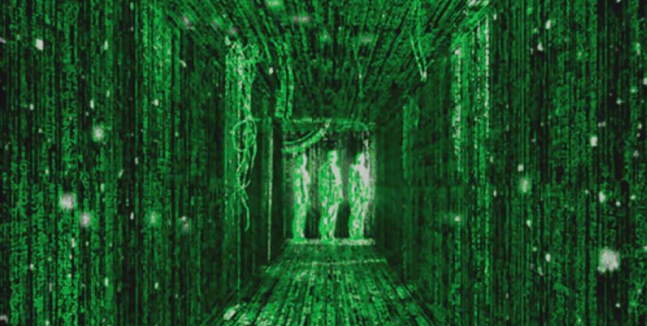
In Closing: The purpose of this essay was to show that the Matrix Trilogy does indeed make sense from a purely sci-fi perspective. No religious conversations necessary here – I’m not expecting you to magically love the sequels now even if you understand and accept my reasoning – I’m just providing you some points for you to consider. Feel free to reject them or call me a loon. But if you find yourself re-watching these movies, try this viewpoint on and see how it fits.





